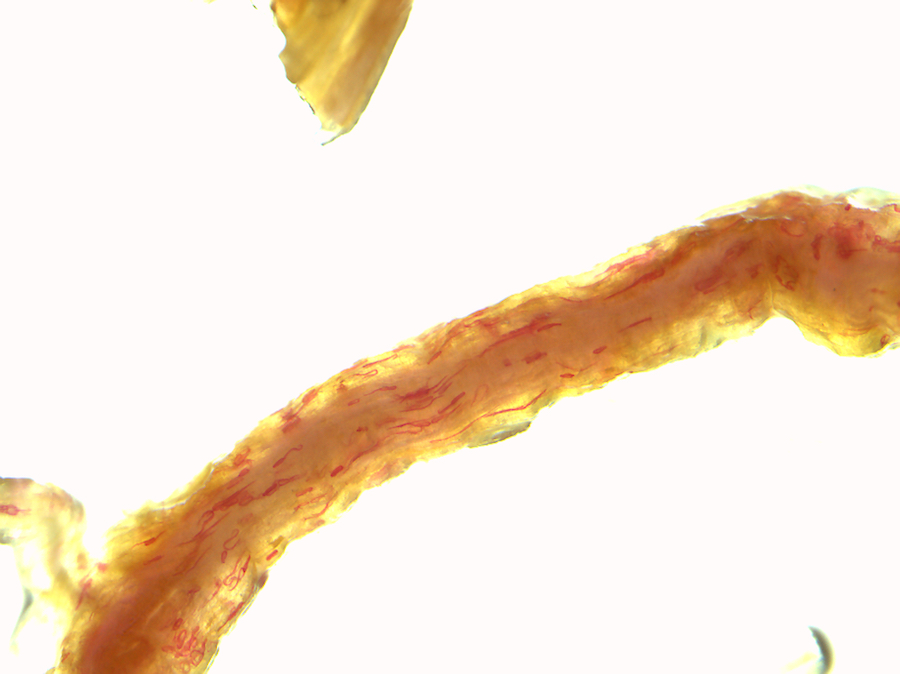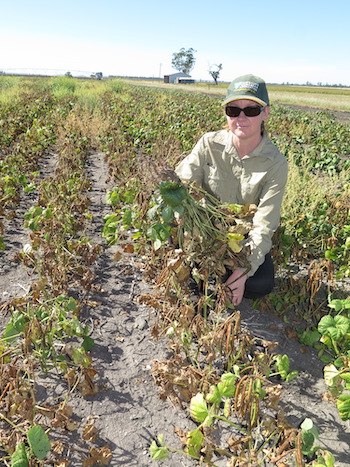Victoria: The CropSafe program
By Kellyanne Harris
 Barley plant sample submitted to CropSafe with a foliar disease. Good sampling method was used and roots and leaves were able to be examined. Photo: Agriculture Victoria
Barley plant sample submitted to CropSafe with a foliar disease. Good sampling method was used and roots and leaves were able to be examined. Photo: Agriculture Victoria
CropSafe is Victoria’s surveillance system for new pests and diseases across the grainbelt.
During 2021, more than 200 agronomists inspected more than 1.5 million hectares of crops in Victoria as part of the program.
CropSafe’s network of agronomists submit plant samples with unusual, unknown or potentially exotic symptoms during the year.
Any suspicious samples are sent on to Crop Health Services for formal identification.
Once a sample has been identified, agronomists are provided with a report detailing which diseases/pests were identified in the sample.
At the end of the year, the data collected provides a level of confidence that many exotic pests and diseases are not present in the Victorian grains industry.
CropSafe has been successful in detecting and supporting the identification and tracking of a range of exotic pests and diseases.
Included among these detections are Russian wheat aphid spread during 2016 and supporting identification of fall armyworm during 2020-21.
NSW: Regional exercises increase biosecurity fitness
By Kate Glastonbury, NSW grains biosecurity officer
In NSW, the Department of Primary Industries (DPI) is the lead agency for responding to plant pest incursions, but it works closely with other agencies, such as the NSW Local Land Services (LLS) when an emergency response occurs. Regular training exercises simulating exotic plant pest incursions (and related surveillance activities) test their ability to work together and that their processes are constantly fit for purpose.
In the 2021-22 financial year, NSW DPI and LLS were able to complete three regional training exercises related to high-priority pests from the grains industry, one in the central-west and another in the north-west.
The third collaborative exercise was called operation ‘snailed it’ – a hybrid training exercise and surveillance collaboration completed by NSW DPI, Murray LLS and Riverina LLS in May 2022. In addition to increasing operational skills, data was gathered to support NSW claims for freedom for an exotic snail. Diagnostics of samples collected during the exercise confirmed that no exotic snails were found during the operation.

Root lesion nematode in a vetch root. Photo: Agriculture Victoria
South Australia: Plant Health Surveillance
By Shafiya Hussein, SA grains biosecurity officer
South Australia’s Department of Primary Industries and Regions (PIRSA) conducts general and targeted surveillance for exotic pests and those already present in other parts of Australia. This activity is undertaken in support of market access and to maximise the likelihood of successful eradication following any incursion.
South Australia collaborates with Plant Health Australia, the Australian Department of Agriculture, Fisheries and Forestry, industry and research bodies in these programs.
The Grains Farm Biosecurity Program (GFBP) is presently conducting surveillance for Khapra beetle and phosphine resistant grain storage insects in South Australia.
Other surveillance in South Australia includes the following pests that are known to be in other states but are not currently present here:
- polyphagous shot-hole borer (Euwallacea fornicates) – detrimental to fruit trees, nut trees and forestry industry; and
- tomato potato psyllid (Bactericera cockerelli) – detrimental to vegetable crops.
In addition, PIRSA participates in national programs, such as the National Bee Surveillance Program and the National Plant Health Surveillance Program, to ensure that it can detect and rapidly respond to any exotic pest incursions.
The efficacy of PIRSA’s surveillance systems has been demonstrated in recent years through the early detection and successful eradication of pests such as giant pine scale (Marchalina hellenica), a pest of forestry and amenity trees.
Western Australia: Biosecurity Blitzes enlist citizen scientists
Adapted from an article by Samantha Scott, Department of Primary Industries and Regional Development (DPIRD)
The MyPestGuideReporter™app is rapidly becoming the go-to tool for citizen science surveys for exotic insect pests. It was developed by the Western Australian Department of Primary Industries and Regional Development (DPIRD).
DPIRD regularly runs initiatives such as the Biosecurity Blitz and Pantry Blitz to raise awareness about damaging pests by asking participants to report using the MyPestGuide® app.
During the Pantry Blitz, sticky traps are sent to participants to place in their pantry for a short period of time to see what insects might be caught. The participants can use the smartphone-based app to photograph the trap, answer a couple of questions and immediately report what was found.
If anything unusual or suspicious is identified, samples can be sent in to DPIRD entomologists for further diagnostics.
Data collected from these apps support Australia’s access to existing or new overseas trade markets and the collected data might help prove Australia’s freedom from certain exotic pests.
More information: mypestguide@dpird.wa.gov.au.
Queensland: Crop surveillance
By Kym McIntyre, Queensland grains biosecurity officer

Queensland pathologists have been undertaking a wide range of structured and random crop surveillance to gain a better understanding of endemic disease trends and to support absence of exotic diseases declarations.
Over the past three years, the team have undertaken targeted surveillance in a wide range of crops including wheat, barley, sorghum, chickpeas, mungbeans, soybeans, faba beans and peanuts.
As well as identifying endemic diseases, the team looked out for key exotic pests, such as exotic stem rusts (Ug99), barley stripe rust, wheat blast, karnal bunt, downy mildew of sorghum and mungbean yellow mosaic virus. The surveys covered the major cropping areas of Queensland, including the Darling Downs and central and north Queensland, as well as a range of coastal cropping regions.
In addition to the surveys, numerous samples were submitted to the Department of Agriculture and Fisheries pathology department for diagnosis.
No exotic pests were detected in the surveillance or the submitted samples. However, the wet summer encouraged an increase in many of the endemic fungal pathogens and viruses found in summer crops. The observed increase signalled a heightened risk for future summer crops.
Data from the surveys has been uploaded into the AUSPestCheck database for future reference.
What looks like net blotch, but isn’t net blotch? Answer: Ramularia leaf spot

Ramularia leaf spot on barley. Photo: FAR Australia
Ramularia leaf spot (RLS) is a fungal disease in barley plants that can reduce grain quality and yield, as well as cause lesions and premature leaf death. It is caused by the pathogen Ramularia collo-cygni, which is a seed and wind-borne fungus that causes toxins called rubellins. These toxins react to light to damage the leaf tissue.
What should I look for?
Lesions will begin to appear on the upper leaves from flowering onwards. Often lesions are only five millimetres long but will lengthen as lesions merge and senesce. Towards the end of the season, small white spores may be found on the underside of the leaf.
The ‘5R’ guide can help identify the disease:
- ringed with yellow margin of chlorosis;
- rectangular shape;
- restricted by the leaf veins;
- reddish-brown colouration; and
- right through the leaf.
More information: GRDC's Ramularia leaf spot in barley factsheet.

























































